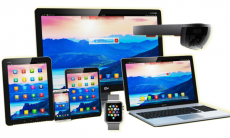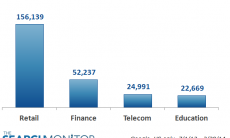 by Aaron Kim
by Aaron Kim
Is there any way to capture a brand’s essence and find out what people really feel about it? That’s the question I pose in my first blog post for Biznology, where we’ll look at a way the Web can tell you more about how the public perceives your brand.
Several months ago, Mike Moran blogged here at Biznology about an interesting
way to measure brand awareness changes as a result of a marketing campaign, not by the means of conventional surveys, which could take weeks or months, but as they happened, using keyword tools to monitor changes in searchers’ behaviour.
Back in May, Noah Brier came up with another way to get a feeling about what people think about a brand. His project, brand tags, is a site that captures “the first thing that pops into your head” when you see a company logo and then displays the collective input as a tag cloud. I tried it out, and compared the tag cloud for the company I work for—IBM—with some other IT companies. Can you guess the companies by their corresponding clouds?

Oddly enough, the first word many people think about when they see the name of the company is the name of the company, so you probably can guess by the position of the smudged tag in each cloud. The companies are, from left to right, IBM, HP, Intel, Microsoft and Apple. As you can notice, I had to bleep some of the tags for HP and Microsoft as those may qualify as R Rated. Being on the business consulting side of IBM, I wanted to add Accenture, CGI and other consulting firms to this comparison, but they are not available yet in that Web site.
Connecting the dots between Mike’s and Noah’s experiments, it would be nice to see brand tags adding one feature: a slider allowing us to see how the brand clouds change over time and determine the time span (e.g., the last 6 months). This way, one could start tracking if there is any clear correlation between brand perception and financial performance, or changes in the brand perception as a result of a marketing campaign.
You may also find their battle of brands concept interesting. This is the top 20 list as of this writing:
- Pixar has 135 wins out of 150 (90%)
- Adidas has 263 wins out of 313 (84.03%)
- Ferrari has 266 wins out of 323 (82.35%)
- Google has 259 wins out of 321 (80.69%)
- Lego has 288 wins out of 363 (79.34%)
- M&Ms has 258 wins out of 329 (78.42%)
- WWF has 245 wins out of 316 (77.53%)
- Nike has 257 wins out of 332 (77.41%)
- YouTube has 249 wins out of 322 (77.33%)
- Canon has 240 wins out of 311 (77.17%)
- National Geographic has 235 wins out of 305 (77.05%)
- Levis has 248 wins out of 322 (77.02%)
- Apple has 245 wins out of 321 (76.32%)
- Heineken has 238 wins out of 312 (76.28%)
- eBay has 215 wins out of 282 (76.24%)
- UPS has 232 wins out of 306 (75.82%)
- BMW has 248 wins out of 328 (75.61%)
- Amazon has 226 wins out of 299 (75.59%)
- Guinness has 239 wins out of 317 (75.39%)
- BBC has 253 wins out of 337 (75.07%)
IBM is #62, with 203 wins out of 289 (70.24%). Make sure you check out the cloud for the top IT brand, Google (#4 overall).
Should your company worry if some of these word associations are not exactly flattering? It’s not very scientific, and it reflects the average opinion of a skewed group, so nobody should panic yet. But the information there is relevant—in a web-two-oh kind of way—and should not be ignored either. It’s very telling to see that many people still link GE with home appliances, even though they’ve become much more than that since their early days, and may in fact be leaving that business soon.
Thinking further about brands, I went back to my Marketing text book and found the following quote about brands:
The most enduring meanings of a brand are its values, culture, and personality. They define the brand’s essence. The Mercedes stands for high technology, performance, and success. Mercedes must project this in its brand strategy. Mercedes must resist marketing an inexpensive car bearing the name; doing so would dilute the value and personality Mercedes has built up over the years.
Just to test how successful Mercedes has been about their brand strategy, I also checked their brand tag, and found it to match the values above almost perfectly. Despite its limitations, Noah’s service seems to be as good as any other technique to capture the public’s perception about a brand:

I also compared two companies in somewhat different lines of business, sneakers and sports apparel: Adidas and Nike. Here’s the head-to-head comparison:

It’s interesting to see an old urban myth showing up in the Adidas cloud. Furthermore, even though both companies have been associated with child labor stories in the past (like in here and here), apparently only Nike continues to be associated with it by the public.
The bottom line is that a mismatch between brand strategy and perceived values may severely impact a company’s ability to reach their business objectives. The examples above just illustrate some possible ways to measure such an elusive concept like a brand’s essence. As tools available to marketers become more sophisticated, relying solely on surveys may prevent companies from seeing the whole picture and being more responsive.






